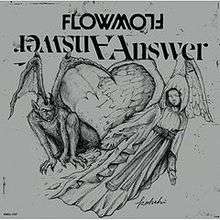Answer
Generally, an answer is a reply to a question. It can be solution, a retaliation or a response to it.
In law, an answer was originally a solemn assertion in opposition to someone or something, and thus generally any counter-statement or defense, a reply to a question or response, or objection, or a correct solution of a problem.
In the common law, an answer is the first pleading by a defendant, usually filed and served upon the plaintiff within a certain strict time limit after a civil complaint or criminal information or indictment has been served upon the defendant. It may have been preceded by an optional "pre-answer" motion to dismiss or demurrer; if such a motion is unsuccessful, the defendant must file an answer to the complaint or risk an adverse default judgment.
In a criminal case, there is usually an arraignment or some other kind of appearance before the defendant comes to court. The pleading in the criminal case, which is entered on the record in open court, is usually either guilty or not guilty. Generally speaking in private, civil cases there is no plea entered of guilt or innocence. There is only a judgment that grants money damages or some other kind of equitable remedy such as restitution or a permanent injunction. Criminal cases may lead to fines or other punishment, such as imprisonment.

Answer (song)
Answer is FLOW's twelfth single. The A-Side was used as opening theme song for the drama Tantei Gakuen. It reached #7 on the Oricon charts in its first week and charted for 12 weeks. *
Track listing
References

Fugue
In music, a fugue (/fjuːɡ/ FEWG) is a contrapuntal compositional technique in two or more voices, built on a subject (theme) that is introduced at the beginning in imitation (repetition at different pitches) and recurs frequently in the course of the composition.
The English term fugue originated in the 16th century and is derived from the French word fugue or the Italian fuga. This in turn comes from Latin, also fuga, which is itself related to both fugere ("to flee") and fugare ("to chase"). The adjectival form is fugal. Variants include fughetta (literally, "a small fugue") and fugato (a passage in fugal style within another work that is not a fugue).
A fugue usually has three sections: an exposition, a development, and a final entry that contains the return of the subject in the fugue's tonic key. Some fugues have a recapitulation. In the Middle Ages, the term was widely used to denote any works in canonic style; by the Renaissance, it had come to denote specifically imitative works. Since the 17th century, the term fugue has described what is commonly regarded as the most fully developed procedure of imitative counterpoint.
Antić
Antić is a Serbo-Croatian surname. It may refer to:
Antic without a diacritical mark may refer to:

Antic (magazine)
Antic ( ISSN 0113-1141) was a home computer magazine devoted to the Atari 8-bit computer line (Atari 400/800 and compatibles). It was published from April 1982 until June/July 1990. Antic published type-in programs (usually in BASIC), reviews, and tutorials, among other articles. Each issue contained one type-in game as "Game of the Month."
History
NASA programmer Jim Capparell was an early Atari 8-bit owner. He quit his job on 15 January 1982 to found a magazine for the computer, named after the ANTIC graphics chip. Companies such as On-Line Systems, Broderbund, and Synapse Software agreed to purchase advertising in the new publication, and Capparell's staff distributed the first issue of 30 pages at the March 1982 West Coast Computer Faire. By Christmas 1983 the magazine was 148 pages, but the popularity of low-end, 8-bit home computers was declining and in 1984 Antic saw advertising sales drop by 50% in 90 days. Its Antic Catalog of public domain software helped the company avoid bankruptcy, and in 1985 it started II Computing for the Apple II series.

ANTIC
Alphanumeric Television Interface Controller (ANTIC) is a LSI ASIC dedicated to generating 2D computer graphics to be shown on a television screen or computer display. Under the direction of Jay Miner, the chip was designed in 1977-1978 by Joe Decuir, Francois Michel, and Steve Smith for Atari 8-bit computers released in 1979 and was patented by Atari, Inc. in 1981. ANTIC is also used in the Atari 5200 video game system release in 1982.
ANTIC is responsible for the generation of playfield graphics which is delivered as a datastream to the related CTIA/GTIA chip. The CTIA/GTIA provides the coloring of the playfield graphics, and is responsible for adding separately moveable, overlay graphics, that is, sprites also known as "Player/Missile graphics" on the Atari.
Atari advertised it as a true microprocessor, in that it has an instruction set to run programs (called display lists) to process data. Nonetheless ANTIC has no capacity for writing back computed values to memory, it merely reads data from memory and processes it for output to the screen, therefore it is not Turing complete.
Podcasts:

